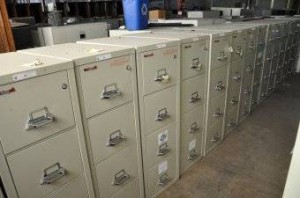
Arnolds has a wide selection of fireproof filing cabinets that can fit your budget.
Think your basic metal filing cabinet will protect your company's vital documents in the event of a fire? Think again. Paper is destroyed at temperatures of 400 degrees and a the temperatures of a structure fire are often much, much hotter, according to SafeteyFile.com.
Despite the trend of digitizing records and storing them in "The Cloud" businesses and individuals still have plenty of important documents on paper or on digital storage devices. Examples of some of these can't-lose records include:
Account histories Bank Statements Birth and Death Certificates Business Contracts Client files Custody Documents Deeds Divorce and Settlement Papers Financial Documents Insurance Policies Marriage Certificates Mortgage Papers Payroll records Passports Prescriptions Product Warranties Standard Operating Procedures Stock and Bond Certificates Tax Papers Wills
To help you out when shopping for your fireproof filing cabinet, we came up with a handy buying guide.
What to look for:
The first thing you'll want to check for on any filing cabinet that's been advertised as "fireproof" is that it has a UL rating.
UL-rated safes and cabinets have been tested by the Underwriter's Laboratory, a non-profit, independent organization that tests manufactured products to ensure they perform to specific standards (you can also look for those that have been tested by another nationally known, independent testing lab). Steer clear of cheap, imported pieces that have been tested by the manufacturer or have non-independent ratings. Also, be wary of products claiming to be "built to" a UL standard; that doesn't mean that the product has been UL tested.
The UL tests fireproof filing cabinets by exposing all six sides to fire (usually in a furnace) and then gives it one of three designations for the type of items it can protect in a fire. They are:
Class 350-rated: Protects paper products. This means that when exposed to external temperatures of 1700 degrees or higher, the internal temperature of the cabinet will not go above 350 degrees (the temperature at which paper products would be ruined and unreadable) for the amount of time designated on the rating. Class 150-rated: Protects magnetic tapes and photographic film. This means that when exposed to external temperatures of 1700 degrees or higher, the internal temperature of the cabinet will not go above 150 degrees (the temperature at which film and magnetic tapes would be ruined) for the amount of time designated on the rating. Class 125-rated: Protects flexible computer disks. This means that when exposed to external temperatures of 1700 degrees or higher, the internal temperature of the cabinet will not go above 125 degrees (the temperature at which digital records such as backup tapes, data cartridges, diskettes, CDS and microfiche would be ruined) for the amount of time designated on the rating.
Fireproof hourly ratings: In addition to temperature ratings, cabinets have different ratings for the amount of time the cabinet can protect the contents for at that temperature: usually one, two or three hours. A Class 350 1-hour means the internal temperature will not go above 350 degrees for one hour; Class 350 2-hour means the internal temperature will not go above 350 degrees for at least two hours, etc. If your business is in a more populated area near a fire department, you would probably be safe with one hour of protection, but if your business is in a more isolated, rural area, it's wiser to to buy yourself more time.
UL Impact Rated: Fireproof filing cabinets might also have this designation on them, which means the product has been tested to withstand a fall from multiple stories. The products are exposed to temperatures of 1550 degrees for one hour then dropped 30 feet and heated again to 1550 degrees for another half hour. Because fires often end in structural collapse, this extra level of protection ensures you're documents will still be protected in both high temperatures and high impact situations.
Look for cabinets that are water resistant as well; in the event of a fire there will likely be sprinklers to deal with as well. There's no use saving your papers from a fire only to drown them!
Keep in mind that even a fireproof safe isn't enough to protect media, which requires protection from temperatures exceeding 125 degrees and humidity levels greater than 80 percent. For those, SafetyFile.com recommends a data safe or media vault.
Other things to consider:
Just as with regular filing cabinets, fireproof cabinets come in a variety of sizes. There are vertical filing cabinets, lateral filing cabinets, document cabinets, filing cabinets that also include a safe, and card files. Take a look at the size of the documents you want to store as well to be sure they can hold both letter and legal-sized paper. Buy for the future, meaning, make sure you buy a cabinet or cabinets that have extra space; you don't want to fill it up right away and not have room for additional documents (and you know there will always be more paperwork!).
Another big logistical factor when it comes to fireproof filing cabinets is weight. These types of cabinets are heavy (for instance, a four-drawer vertical cabinet weighs 435 pounds and a four-drawer lateral cabinet weighs 1,022 pounds). You'll likely need a forklift to move the cabinet, so look for sellers that include delivery and installation.
Finally, keep in mind that fireproof cabinets are more expensive than standard cabinets. The list price for a four-drawer vertical cabinet is $1,759, and for a four-drawer lateral cabinet the cost is upwards of $7,100 plus shipping. Of course, if you're on a tight budget (or just more of a penny pincher) you can always buy used cabinets from Arnolds;?we currently have four-drawer vertical cabinets in stock for $1,050 and four-drawer lateral cabinets for $1,500.





